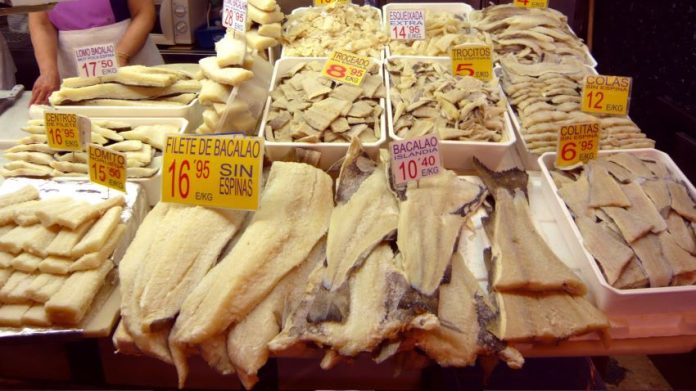I know that it’s a few days out from Christmas when my husband announces it’s time to go the market and buy dried salted cod. He can forego some Mexican traditions, but this is not one of them.
The cod is for a dish called bacalao a la vizcaína (Biscay-style cod), often just simply called bacalao. It, along with romeritos con mole (seepweed in mole sauce), are the Spanish and indigenous stars of Mexican Christmas meals. No holiday table, even one limited to immediate family during a pandemic, is complete without at least one of the two.
The dishes’ role came about during the evangelical period in Mexico. Although the sword was certainly used, the Spanish also imposed Catholicism by co-opting similar traditions and rituals. In the Aztec Empire, the birth celebrations of the god Huitzilopochtli, celebrated around the winter solstice, provided such opportunities.
This included a special midwinter feast. Like much of the Catholic world, families today in Mexico gather on Christmas Eve with the “birth” of Jesus occurring at midnight. This birth might be celebrated at Mass or at home, but in either case, it means adding an image of the infant Jesus to the home nativity scene.
Like elsewhere around the world, the dinner that accompanies this ritual is very much a family affair. One interesting note is that this feast is often repeated on New Year’s Eve in Mexico rather than going out to get drunk.

In many cases, Mexican dishes evolved with a mix of Old and New World ingredients; this is not entirely the case with bacalao and romeritos. The two dishes have mostly conserved their original recipes.
Abstaining from meat is a kind of penance, but those who could afford to substituted fish because seafood was not considered meat. The demand for seafood in locales far from bodies of water drove a centuries-long industry for salted and dried cod, as well as associating this cod with holiday eating.
The Spanish brought the concept and prestige of cod with them to Mexico, and the Biscay stew recipe became the norm for the Christmas holiday. That recipe, with its use of green olives and capers, rarely found in Mexican cuisine, betrays its Spanish roots. The only modifications made since the dish’s introduction have been the inclusion of tomatoes and pickled güero chile peppers from the New World.
Romeritos con mole is the indigenous contribution to the Christmas table. The dish is very old, with a version of it documented shortly after the Conquest by historian Fray Bernardino de Sahagún. Romeritos are one of many edible greens that grow naturally in and around tilled fields. They played an important role in the diets of the indigenous and later the poor, who had little access to meat or other animal products. The mole sauce would be adopted by the Spanish, who put it on turkey and other fowl but considered romeritos nothing more than weeds.
But the dish was and is special. Firstly, the greens were associated with the birth of Huitzlopochili. In addition, it took much time and effort to grind the seeds and dried chile peppers for the mole. The dish can still be served in all its vegetarian glory, but it too has suffered some modification: there are now versions that add reconstituted dried shrimp or a kind of “meatball” of dried shrimp mixed with egg and flour.
While both dishes are traditional, bacalao holds the upper hand on the Christmas table, likely due to its historical association with the Spanish elites. Such cod is still expensive, with that fished from Norwegian waters most prized. The whitest flesh commands the highest price.

In fact, the demand is such that shark or even endangered fish species often masquerade as bacalao in Mexican markets. Shark impostors can be identified by their yellow flesh.
Because it is bought salted and dried, Christmas bacalao preparation must start days in advance. The fish needs to be rehydrated, but the water also needs to be changed various times to remove as much of the salt as possible.
The preparation of bacalao is almost the same everywhere it is consumed in Mexico, probably because of its strong ties to tradition, like the preparation of roast turkey in the U.S. and Canada. But one twist that has shown up in Mexico City markets is tortas de bacalao — traditionally prepared bacalao spooned into a crusty roll called a bolillo and eaten as seasonal street food. But then there is a joke that people from Mexico City will eat anything put in a bolillo.
In my opinion, both dishes are something of an acquired taste. Reconstituted cod and shrimp often have a texture that can turn people off. However, using fresh versions does not work for either recipe as the flesh would simply dissolve. Dark greens like romeritos can have a strong flavor as well. But for those who grow up with these dishes, there is no substitute.
Leigh Thelmadatter arrived in Mexico 17 years ago and fell in love with the land and the culture. She publishes a blog called Creative Hands of Mexico and her first book, Mexican Cartonería: Paper, Paste and Fiesta, was published last year. Her culture blog appears weekly on Mexico News Daily.
